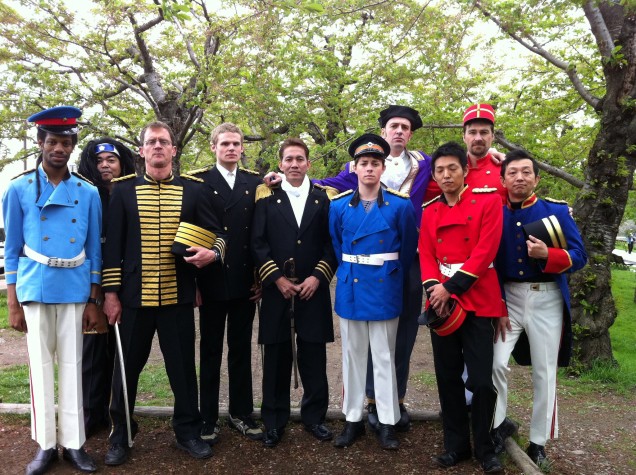By Ben Mirin, CIR
As seen in the Concord Journal bi-monthly column, “The Japan Connection.”
May 22nd, 2011

Any crowd of foreigners in Hakodate is usually very conspicuous, but in my search for the starting point of this year’s Goryokaku Festival, I knew I had no way of asking for directions. Asking passersby downtown where I could find a crowd of foreigners in 19th century military garb surely would have drawn blank stares.
Now in its 42nd year, the Goryokaku Festival is never complete without foreign volunteers. Festival organizers use word of mouth to recruit them to march as soldiers and flag bearers in the Meiji Restoration Parade. Every year on the Sunday after the third Saturday in May, this huge event commemorates the end of Japan’s Boshin War period with reenactments of the Battle of Hakodate in Goryokaku Square.
“Ben!”
Hearing my name with perfect American pronunciation catches me off guard nowadays. My friend Bill Bowman, a 10-year veteran flag-bearer for the Parade, was waving to me from across the street.
“Let’s go get you into costume,” he said. For the first time, I noticed his mid-western accent, or what was left of it after 16 years of living in Hakodate.
We walked together for a mere five minutes before the clang of Japanese katana and synchronized shouts from reenactment volunteers were clearly audible in the Sunday morning stillness. I passed through crowds of Japanese high school students dressed in the colors of the Meiji and the Tokugawa shogunate armies and ascended the stairs to the costume room.
Upstairs, a man in a shogunate uniform greeted me and gestured to a group of boldly dressed men at the far end of a large tatami room.
The flag-bearer’s role in the Meiji Restoration Parade is more about symbolism than accuracy. Bill donned a Dutch uniform and introduced me to the group: a Guyanese man leaning on an old Russian flag, a Filipino man wielding the French flag, and an Englishman in a neon-purple coat that supposedly reflected contemporary British navy attire.
- Foreign volunteers who marched in the parade (Nations represented L to R: Russia, Tokugawa, France, the United States, England, the Netherlands, and France)
“These were the first five nations to establish foreign consulates in Hakodate,” Bill explained. Despite some inaccuracies were accounted for.
Around midday the parade began. Marching behind a smartly-dressed Commodore Matthew Perry, played every year by Japanese American Friendship Society representative and Hakodate native Kioro Kato, I held the American flag aloft and scanned the crowd for familiar faces.
…A friend from the JET Programme…
…A young drummer who had joined me onstage at Pub the Beats, a downtown blues venue, the night before…
The parade followed a path through Goryokaku Square and into the remnants of the old fort at Goryokaku Park, where the Battle of Hakodate concluded on May 17th, 1869. After processing across a large stage in the park’s center, we all stood to attention as the Festival organizers gave speeches and occasionally fired mock cannons or tossed handfuls of mochi (Japanese glutinous rice cake) into the crowd.

Our soldierly discipline was short lived in the beautiful spring sunshine, however. Tourists and Hakodate natives converged on the flag-bearers, requesting first individual and then group pictures. By the end of the ceremony, all the parade volunteers were posing for photographs as the group made its way slowly out of the park, boarded a bus, and returned to the costume room.
Little more than a month had passed since the Patriot’s Day celebrations in Concord. Having slept through the early-morning reenactments that day, I was happy for another surprise chance to show my patriotism on the other side of the Pacific.♦
Please consider leaving a comment on this post in the comment section below, or subscribing to the RSS feed to have future articles delivered to your feed reader.
To submit suggestions for future content, please email concordnanae@gmail.com. Thank you for visiting ConcordNanae.org.


